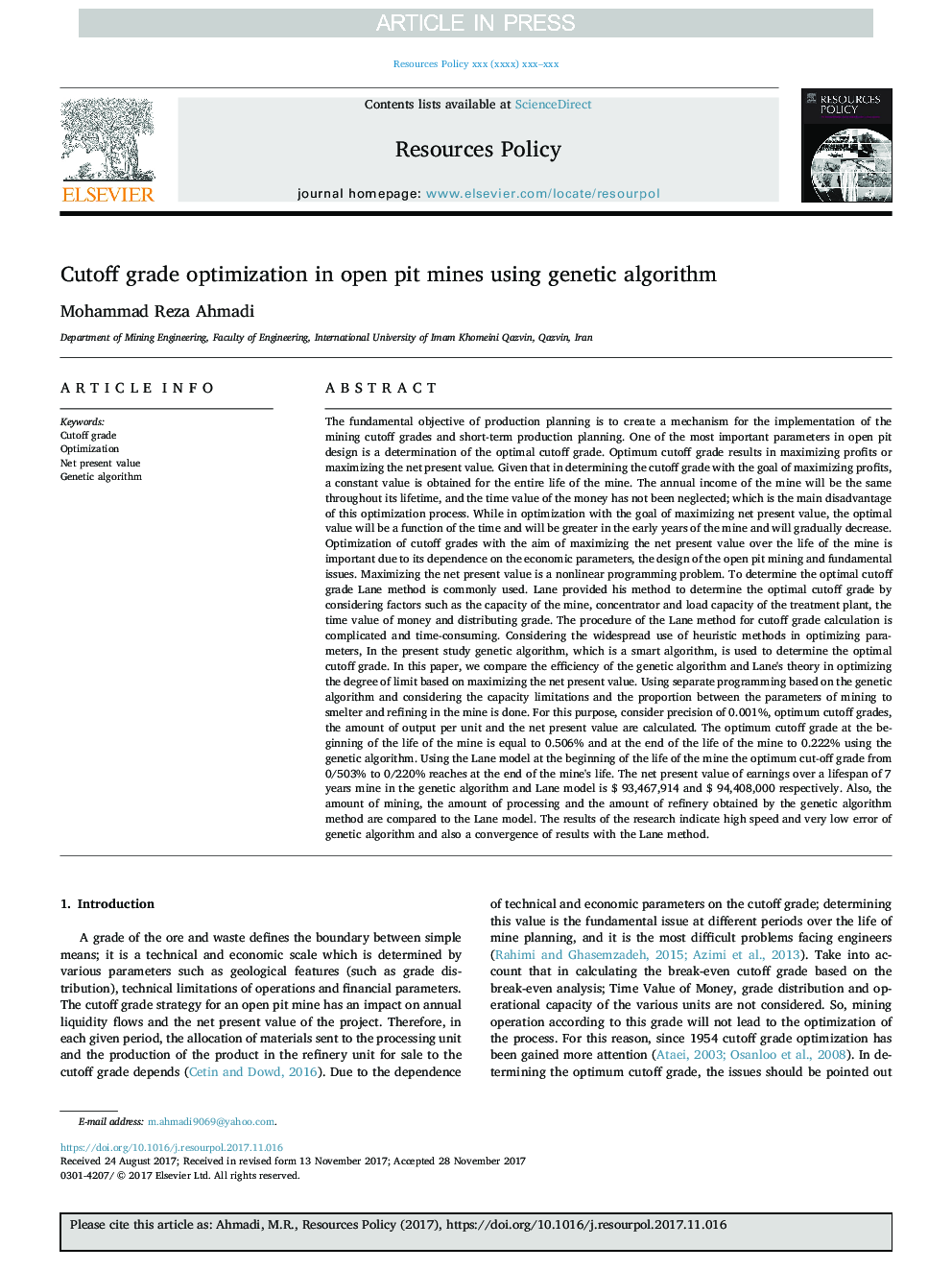| کد مقاله | کد نشریه | سال انتشار | مقاله انگلیسی | نسخه تمام متن |
|---|---|---|---|---|
| 7387608 | 1480748 | 2018 | 8 صفحه PDF | دانلود رایگان |
عنوان انگلیسی مقاله ISI
Cutoff grade optimization in open pit mines using genetic algorithm
ترجمه فارسی عنوان
بهینه سازی درجه کاهش در معادن گودال با استفاده از الگوریتم ژنتیک
دانلود مقاله + سفارش ترجمه
دانلود مقاله ISI انگلیسی
رایگان برای ایرانیان
کلمات کلیدی
درجه برش بهینه سازی، ارزش خالص فعلی، الگوریتم ژنتیک،
موضوعات مرتبط
مهندسی و علوم پایه
علوم زمین و سیارات
زمین شناسی اقتصادی
چکیده انگلیسی
The fundamental objective of production planning is to create a mechanism for the implementation of the mining cutoff grades and short-term production planning. One of the most important parameters in open pit design is a determination of the optimal cutoff grade. Optimum cutoff grade results in maximizing profits or maximizing the net present value. Given that in determining the cutoff grade with the goal of maximizing profits, a constant value is obtained for the entire life of the mine. The annual income of the mine will be the same throughout its lifetime, and the time value of the money has not been neglected; which is the main disadvantage of this optimization process. While in optimization with the goal of maximizing net present value, the optimal value will be a function of the time and will be greater in the early years of the mine and will gradually decrease. Optimization of cutoff grades with the aim of maximizing the net present value over the life of the mine is important due to its dependence on the economic parameters, the design of the open pit mining and fundamental issues. Maximizing the net present value is a nonlinear programming problem. To determine the optimal cutoff grade Lane method is commonly used. Lane provided his method to determine the optimal cutoff grade by considering factors such as the capacity of the mine, concentrator and load capacity of the treatment plant, the time value of money and distributing grade. The procedure of the Lane method for cutoff grade calculation is complicated and time-consuming. Considering the widespread use of heuristic methods in optimizing parameters, In the present study genetic algorithm, which is a smart algorithm, is used to determine the optimal cutoff grade. In this paper, we compare the efficiency of the genetic algorithm and Lane's theory in optimizing the degree of limit based on maximizing the net present value. Using separate programming based on the genetic algorithm and considering the capacity limitations and the proportion between the parameters of mining to smelter and refining in the mine is done. For this purpose, consider precision of 0.001%, optimum cutoff grades, the amount of output per unit and the net present value are calculated. The optimum cutoff grade at the beginning of the life of the mine is equal to 0.506% and at the end of the life of the mine to 0.222% using the genetic algorithm. Using the Lane model at the beginning of the life of the mine the optimum cut-off grade from 0/503% to 0/220% reaches at the end of the mine's life. The net present value of earnings over a lifespan of 7 years mine in the genetic algorithm and Lane model is $ 93,467,914 and $ 94,408,000 respectively. Also, the amount of mining, the amount of processing and the amount of refinery obtained by the genetic algorithm method are compared to the Lane model. The results of the research indicate high speed and very low error of genetic algorithm and also a convergence of results with the Lane method.
ناشر
Database: Elsevier - ScienceDirect (ساینس دایرکت)
Journal: Resources Policy - Volume 55, March 2018, Pages 184-191
Journal: Resources Policy - Volume 55, March 2018, Pages 184-191
نویسندگان
Mohammad Reza Ahmadi, Reza Shakoor Shahabi,
